[English] 日本語
 Yorodumi
Yorodumi- EMDB-21668: Capsid structure of Penaeus monodon metallodensovirus following E... -
+ Open data
Open data
- Basic information
Basic information
| Entry | Database: EMDB / ID: EMD-21668 | ||||||||||||||||||
|---|---|---|---|---|---|---|---|---|---|---|---|---|---|---|---|---|---|---|---|
| Title | Capsid structure of Penaeus monodon metallodensovirus following EDTA treatment | ||||||||||||||||||
 Map data Map data | Capsid structure of Penaeus monodon metallodensovirus, EDTA-treated | ||||||||||||||||||
 Sample Sample |
| ||||||||||||||||||
 Keywords Keywords | parvovirus / densovirus / Penaeus monodon / crustacean / pathogen / Parvovirinae / metallodensovirus / shrimp / prawn / capsid / VIRUS LIKE PARTICLE | ||||||||||||||||||
| Biological species |  Penaeus monodon metallodensovirus Penaeus monodon metallodensovirus | ||||||||||||||||||
| Method | single particle reconstruction / cryo EM / Resolution: 2.78 Å | ||||||||||||||||||
 Authors Authors | Penzes JJ / Pham HT | ||||||||||||||||||
| Funding support |  Canada, Canada,  United States, 5 items United States, 5 items
| ||||||||||||||||||
 Citation Citation |  Journal: Proc Natl Acad Sci U S A / Year: 2020 Journal: Proc Natl Acad Sci U S A / Year: 2020Title: Molecular biology and structure of a novel penaeid shrimp densovirus elucidate convergent parvoviral host capsid evolution. Authors: Judit J Pénzes / Hanh T Pham / Paul Chipman / Nilakshee Bhattacharya / Robert McKenna / Mavis Agbandje-McKenna / Peter Tijssen /   Abstract: The giant tiger prawn () is a decapod crustacean widely reared for human consumption. Currently, viruses of two distinct lineages of parvoviruses (PVs, family ; subfamily ) infect penaeid shrimp. ...The giant tiger prawn () is a decapod crustacean widely reared for human consumption. Currently, viruses of two distinct lineages of parvoviruses (PVs, family ; subfamily ) infect penaeid shrimp. Here, a PV was isolated and cloned from Vietnamese specimens, designated metallodensovirus (PmMDV). This is the first member of a third divergent lineage shown to infect penaeid decapods. PmMDV has a transcription strategy unique among invertebrate PVs, using extensive alternative splicing and incorporating transcription elements characteristic of vertebrate-infecting PVs. The PmMDV proteins have no significant sequence similarity with other PVs, except for an SF3 helicase domain in its nonstructural protein. Its capsid structure, determined by cryoelectron microscopy to 3-Å resolution, has a similar surface morphology to densovirus, despite the lack of significant capsid viral protein (VP) sequence similarity. Unlike other PVs, PmMDV folds its VP without incorporating a βA strand and displayed unique multimer interactions, including the incorporation of a Ca cation, attaching the N termini under the icosahedral fivefold symmetry axis, and forming a basket-like pentamer helix bundle. While the PmMDV VP sequence lacks a canonical phospholipase A2 domain, the structure of an EDTA-treated capsid, determined to 2.8-Å resolution, suggests an alternative membrane-penetrating cation-dependent mechanism in its N-terminal region. PmMDV is an observed example of convergent evolution among invertebrate PVs with respect to host-driven capsid structure and unique as a PV showing a cation-sensitive/dependent basket structure for an alternative endosomal egress. | ||||||||||||||||||
| History |
|
- Structure visualization
Structure visualization
| Movie |
 Movie viewer Movie viewer |
|---|---|
| Structure viewer | EM map:  SurfView SurfView Molmil Molmil Jmol/JSmol Jmol/JSmol |
| Supplemental images |
- Downloads & links
Downloads & links
-EMDB archive
| Map data |  emd_21668.map.gz emd_21668.map.gz | 78.3 MB |  EMDB map data format EMDB map data format | |
|---|---|---|---|---|
| Header (meta data) |  emd-21668-v30.xml emd-21668-v30.xml emd-21668.xml emd-21668.xml | 16.3 KB 16.3 KB | Display Display |  EMDB header EMDB header |
| Images |  emd_21668.png emd_21668.png | 99.9 KB | ||
| Filedesc metadata |  emd-21668.cif.gz emd-21668.cif.gz | 6.3 KB | ||
| Archive directory |  http://ftp.pdbj.org/pub/emdb/structures/EMD-21668 http://ftp.pdbj.org/pub/emdb/structures/EMD-21668 ftp://ftp.pdbj.org/pub/emdb/structures/EMD-21668 ftp://ftp.pdbj.org/pub/emdb/structures/EMD-21668 | HTTPS FTP |
-Validation report
| Summary document |  emd_21668_validation.pdf.gz emd_21668_validation.pdf.gz | 453.3 KB | Display |  EMDB validaton report EMDB validaton report |
|---|---|---|---|---|
| Full document |  emd_21668_full_validation.pdf.gz emd_21668_full_validation.pdf.gz | 452.8 KB | Display | |
| Data in XML |  emd_21668_validation.xml.gz emd_21668_validation.xml.gz | 7.5 KB | Display | |
| Data in CIF |  emd_21668_validation.cif.gz emd_21668_validation.cif.gz | 8.7 KB | Display | |
| Arichive directory |  https://ftp.pdbj.org/pub/emdb/validation_reports/EMD-21668 https://ftp.pdbj.org/pub/emdb/validation_reports/EMD-21668 ftp://ftp.pdbj.org/pub/emdb/validation_reports/EMD-21668 ftp://ftp.pdbj.org/pub/emdb/validation_reports/EMD-21668 | HTTPS FTP |
-Related structure data
| Related structure data |  6wh7MC  6wh3C C: citing same article ( M: atomic model generated by this map |
|---|---|
| Similar structure data |
- Links
Links
| EMDB pages |  EMDB (EBI/PDBe) / EMDB (EBI/PDBe) /  EMDataResource EMDataResource |
|---|
- Map
Map
| File |  Download / File: emd_21668.map.gz / Format: CCP4 / Size: 246 MB / Type: IMAGE STORED AS FLOATING POINT NUMBER (4 BYTES) Download / File: emd_21668.map.gz / Format: CCP4 / Size: 246 MB / Type: IMAGE STORED AS FLOATING POINT NUMBER (4 BYTES) | ||||||||||||||||||||||||||||||||||||||||||||||||||||||||||||||||||||
|---|---|---|---|---|---|---|---|---|---|---|---|---|---|---|---|---|---|---|---|---|---|---|---|---|---|---|---|---|---|---|---|---|---|---|---|---|---|---|---|---|---|---|---|---|---|---|---|---|---|---|---|---|---|---|---|---|---|---|---|---|---|---|---|---|---|---|---|---|---|
| Annotation | Capsid structure of Penaeus monodon metallodensovirus, EDTA-treated | ||||||||||||||||||||||||||||||||||||||||||||||||||||||||||||||||||||
| Projections & slices | Image control
Images are generated by Spider. | ||||||||||||||||||||||||||||||||||||||||||||||||||||||||||||||||||||
| Voxel size | X=Y=Z: 1.059 Å | ||||||||||||||||||||||||||||||||||||||||||||||||||||||||||||||||||||
| Density |
| ||||||||||||||||||||||||||||||||||||||||||||||||||||||||||||||||||||
| Symmetry | Space group: 1 | ||||||||||||||||||||||||||||||||||||||||||||||||||||||||||||||||||||
| Details | EMDB XML:
CCP4 map header:
| ||||||||||||||||||||||||||||||||||||||||||||||||||||||||||||||||||||
-Supplemental data
- Sample components
Sample components
-Entire : Penaeus monodon metallodensovirus
| Entire | Name:  Penaeus monodon metallodensovirus Penaeus monodon metallodensovirus |
|---|---|
| Components |
|
-Supramolecule #1: Penaeus monodon metallodensovirus
| Supramolecule | Name: Penaeus monodon metallodensovirus / type: virus / ID: 1 / Parent: 0 / Macromolecule list: all / NCBI-ID: 2672571 / Sci species name: Penaeus monodon metallodensovirus / Virus type: VIRUS-LIKE PARTICLE / Virus isolate: OTHER / Virus enveloped: No / Virus empty: Yes |
|---|---|
| Host (natural) | Organism:  Penaeus monodon (black tiger shrimp) Penaeus monodon (black tiger shrimp) |
| Virus shell | Shell ID: 1 / T number (triangulation number): 1 |
-Macromolecule #1: Penaeus monodon metallodensovirus major capsid protein
| Macromolecule | Name: Penaeus monodon metallodensovirus major capsid protein type: protein_or_peptide / ID: 1 / Number of copies: 60 / Enantiomer: LEVO |
|---|---|
| Source (natural) | Organism:  Penaeus monodon metallodensovirus Penaeus monodon metallodensovirus |
| Molecular weight | Theoretical: 41.130918 KDa |
| Recombinant expression | Organism:  |
| Sequence | String: MSDEVSSSTD VVSRKRRRHD EGGKALEDIA VHGASEGDGS APGGSVWQTT DYIALSMVVY RTAIKLRNFV NIRGLTPTEM IVIPWNVMR FYCEYNTGTY GLSGNVHHKN YSMLLACKAH RPTKVGYTLS NLILTSDELV STGGTLGTTT TFNTSPYMIH S IDDQQCLS ...String: MSDEVSSSTD VVSRKRRRHD EGGKALEDIA VHGASEGDGS APGGSVWQTT DYIALSMVVY RTAIKLRNFV NIRGLTPTEM IVIPWNVMR FYCEYNTGTY GLSGNVHHKN YSMLLACKAH RPTKVGYTLS NLILTSDELV STGGTLGTTT TFNTSPYMIH S IDDQQCLS KVYPKTDTVW PVSSMRELDY VASTVSGDNA IIPSTIFNKN RYWKQGDDAL HFSHDLDLGF WFGSDYGNAY VP QNNDSMN AVGTIPTSKH INVRGVNNRG MAGHYLSFPP IRTNDGQFKL NAQFTLETEI EFEFRLWEQG VQGINSVHTN LNP ANDSLW IQSYGSLVSI TESKINNIQF GPTCPRVDAR NKGGKMSMLF DHH |
-Experimental details
-Structure determination
| Method | cryo EM |
|---|---|
 Processing Processing | single particle reconstruction |
| Aggregation state | particle |
- Sample preparation
Sample preparation
| Buffer | pH: 8.2 Component - Name: Universal buffer, supplemented with 100 mM EDTA Details: 20 mM HEPES, 20 mM MES, 20 mM sodium acetate, 0.15 M NaCl, 3.7 mM CaCl2, 100 mM EDTA |
|---|---|
| Grid | Details: unspecified |
| Vitrification | Cryogen name: ETHANE |
- Electron microscopy
Electron microscopy
| Microscope | FEI TITAN KRIOS |
|---|---|
| Image recording | Film or detector model: GATAN K3 (6k x 4k) / Number grids imaged: 1 / Average electron dose: 60.0 e/Å2 |
| Electron beam | Acceleration voltage: 300 kV / Electron source: OTHER |
| Electron optics | Illumination mode: SPOT SCAN / Imaging mode: BRIGHT FIELD |
| Experimental equipment |  Model: Titan Krios / Image courtesy: FEI Company |
 Movie
Movie Controller
Controller


 UCSF Chimera
UCSF Chimera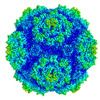


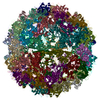

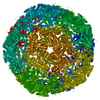
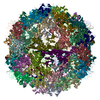
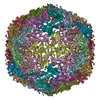

 Z (Sec.)
Z (Sec.) X (Row.)
X (Row.) Y (Col.)
Y (Col.)





















